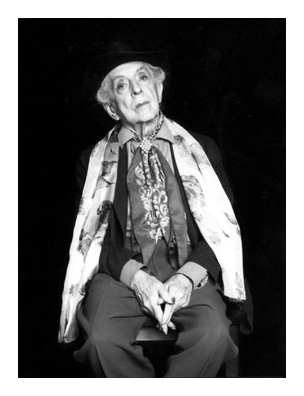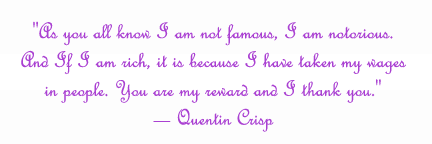 REMEMBERING QUENTIN CRISP by Anne-Margret Bellavoine |
|
London in the late sixties and early seventies was just about the coolest, hippest place there has ever been or ever will be, nostalgic distortion notwithstanding.
Thirty years ago, I was a bright-eyed young intellectual, artistic wannabe who had emigrated from my native France to immerse myself into the heady experience of "The Scene." Via a convoluted path, I was led to the prosaic, unglamorous East End where an alternative, avant-gardish community group was willing to take me in and give me a chance. It was a "straight commune," and I soon found a soul mate within its ranks. As one cannot live on love and fresh water, or even community arts events, we all had to find a way to bring in extra income. I temped as a secretary, always one of my fallbacks, and, of course, modeled in art school. Our wardrobe provided great outfits and I still have a picture of me looking like a circus animal trainer, complete with racy black boots, sleek white jodhpurs and a high top hat. The art teacher in residence at East Ham Community College was Arthur Ruff, a gentle man and gentleman with debonair bonhomie. Along with my friend Mary Gayton, my mother surrogate after my own mother died, I took occasional classes there, keeping up my hand and eye skills of sketching live figure or still-life poses and compositions. One day as I entered the studio, Arthur introduced me to another model who had deigned to grace our modest locale by his magnanimous presence — Quentin Crisp, of notorious fame. Every inch of him bespoke an ineffable quality — that of love of life with an appreciation of art and the higher realms of culture and refinement. He effused a je ne sais quoi which I perceived then and has remained with me for three decades, that elusive air of supreme grandeur which elevated him on the pedestal of humanity. Overtly flamboyant, he was nevertheless obviously genuinely humane, affable and courteous, and yet imbued with immense originality, from his cocked fedora to his silk chiffon cravat. He loved the human shape, his and that of his lovers’, and wanted to share this passion with the students of the nude figure. In every one of his portraits, he is uniquely himself, aesthetically charming and potent in a subtly androgynous way that defies categorization. As a middle-aged woman in a transition crisis on many fronts, I feel safest with a coterie of gay men and all they have to share — their earnestness and refined culture, a refreshing change from domineering boorish machismo. I never forgot Quentin since that brief encounter. He made this world a more intriguingly satisfying place simply by his being himself. |
|
Photograph copyright © Dana Frank. All rights reserved. Used by permission.
Text copyright © Anne-Margret Bellavoine. All rights reserved. Used by permission.   Site Copyright © 1999–2007 by the Quentin Crisp Archives All rights reserved. |